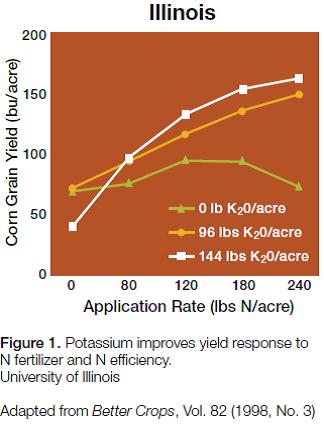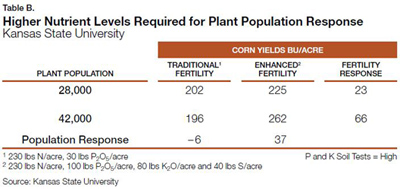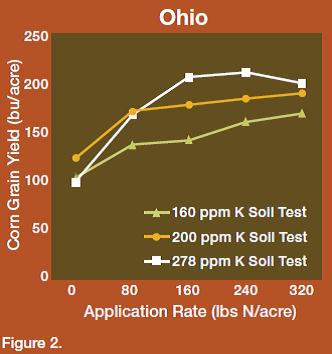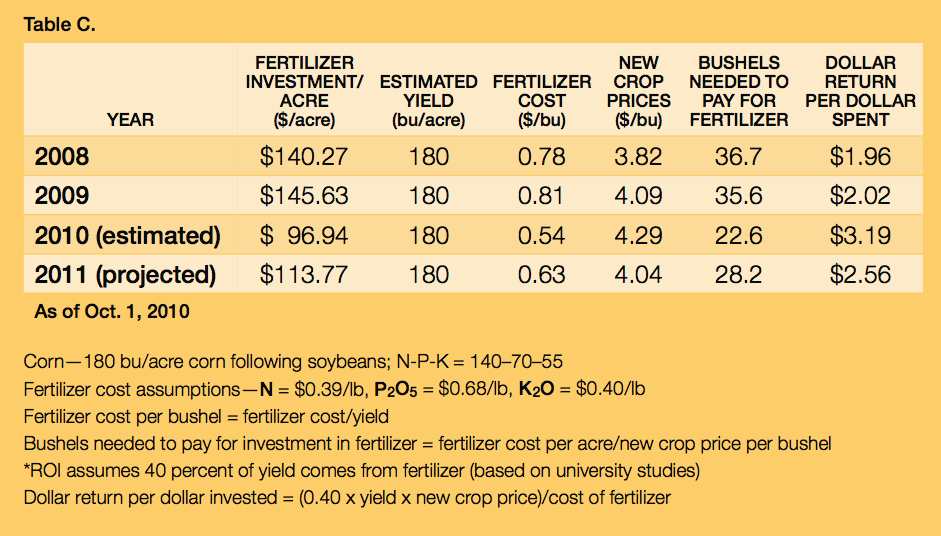By understanding how nutrients work together, farmers can optimize production and investment in fertilizer while minimizing the opportunity for excess nutrients to negatively impact the environment. Potassium (K) and nitrogen (N) are two vital nutrients that create greater benefits working together than alone.
Research studies from the University of Illinois illustrate how potassium nutrition and fertilizer N interact to markedly increase yield response to fertilizer N and N use efficiency (Figure 1). It is important to keep in mind that these same types of P and K interactions will also occur with other nutrients and non-nutrient crop inputs.

What do these interactions mean for the future?
With technology and production changes, U.S. corn yields have increased from about 100 bushels per acre in 1985 to approximately 160 bushels per acre in 2009. Many farmers are growing corn yielding more than 200 bushels per acre.
But can traditional nutrient recommendations meet the demands of tomorrow’s high corn yields? Evidence suggests the levels of inputs and management necessary for corn yields in the 150 bushels per acre range may not be enough for modern yield levels of 250-plus bushels per acre.
A Kansas study combined higher plant populations and an enhanced fertility program to maximize irrigated-corn yields (Table B). With traditional university nutrient recommendations, the higher plant populations yielded slightly less than the traditional lower populations. However, when the fertility program included additional P, K and sulfur (S), the higher plant population yielded 37 bushels per acre more than the traditional lower plant population. Likewise, corn response to the enhanced fertility program was only 23 bushels per acre at the lower plant population, but swelled to an impressive 66 bushels per acre at the higher population.
Balanced and fully adequate fertility programs will be fundamental components of optimizing return in the future from improved genetics and new technologies and practices while protecting the environment.
Optimizing potassium critical for top yields

Soil test trends coupled with environmental factors indicate applying potassium (K) fertilizer may be more important than ever for optimum crop yields. According to studies from the International Plant Nutrition Institute (IPNI), soil test K levels continue to decrease, and as a result, the percentage of soils across North America in negative balance for K continues to rise.
“Research at Ohio State shows that yields increased as soil test K increased above critical soil levels,” explains Dan Froehlich, agronomist with The Mosaic Company. “A standard benchmark is that potassium uptake for a 180-bushel corn yield is 240 pounds of potassium per acre. The critical level of potassium in the soil for optimum performance is approximately 165 ppm.
“The Ohio State results show yields increased as K increased to 200 ppm and 278 ppm. Nitrogen use also was enhanced as soil K levels increased,” Froehlich adds. Agronomic and environmental conditions also play a role in the availability of nutrients for plant uptake. These factors make supplemental K even more important to optimize yields.
“Cool, wet years set up agronomic challenges for crops that exacerbate the impact of limited soil nutrients,” says Steve Phillips, Southeast U.S. region director with IPNI, a nonprofit, science-based organization focusing on agronomic education and research support. “Season-long excess soil moisture and resulting compaction from planting, spraying and harvest cause poor soil aeration.

“Oxygen is required for root nutrient uptake; damp, compacted soils are lower in soil oxygen, thus limiting plants’ ability to uptake K. Continued wet conditions make the situation more complex,” Phillips explains.
Insufficient K may lead to reduced nitrogen uptake, less developed roots, lower protein content, greater susceptibility to water loss and wilting, as well as weaker stalks that are more prone to lodging.
Prolonged cool temperatures plus wet, compacted soils can cause irreparable damage to yield potential, since corn plants take up more than 50 percent of the total K in the first 50 days. Compaction and wet soils also may limit K uptake shortly before pollination when corn plants remove more than 15 pounds of potassium oxide (K₂O) per acre per day.
“Over time, continued removal of K without annual fertilizer application will lower soil test levels, and yield loss will occur because K removal is a direct contributor to crop yield,” says Phillips.
Fertilizer offers performance that pays

Survival in today’s competitive economic environment depends upon each investment ultimately providing a positive return. In corn production, fertility drives about 40 percent of the crop’s yield — and fertilizer provides a proven, positive return on investment (ROI).¹ Use the formulas below the table to calculate the return from fertilizing your own corn crop.
¹ROI assumes 40 percent of yield comes from fertilizer (based on university studies).